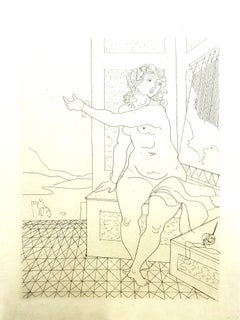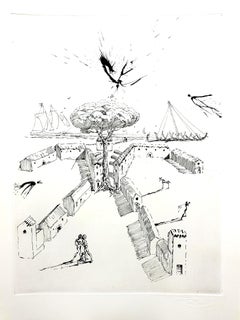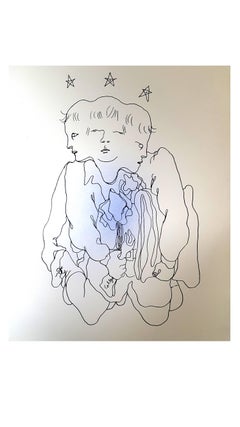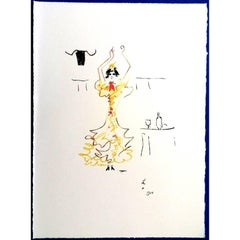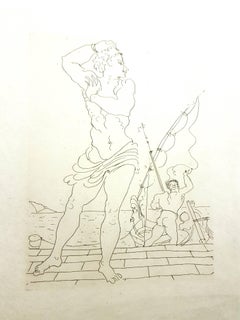Mid-20th Century Nude Prints
to
84
343
147
84
17
6
Overall Width
to
Overall Height
to
280
105
18
14
12
9
6
3
2
55
35
27
24
19
22
55
1,932
427
26
81
118
131
53
138
212
504
258
106
17
465
126
3
458
276
268
187
116
109
106
87
73
13
11
11
11
11
10
10
9
7
7
6
272
221
66
31
26
71
145
306
257
Period: Mid-20th Century
André Derain - Ovid's Heroides - Original Etching
By André Derain
Located in Collonge Bellerive, Geneve, CH
André Derain - Ovid's Heroides
Original Etching
Edition of 134
Dimensions: 32 x 25 cm
Ovide [Marcel Prevost], Héroïdes, Paris, Société des Cent-une, 1938...
Category
Modern Mid-20th Century Nude Prints
Materials
Etching
Salvador Dali - The Drawers
Located in Collonge Bellerive, Geneve, CH
Salvador Dali - The Drawers - Original Etching
Dimensions: 38 x 28 cm
Edition: 235
1967
Embossed signature
On Arches Vellum
References : Field 67-10 (p. 34-35)
Category
Surrealist Mid-20th Century Nude Prints
Materials
Etching
Jean Cocteau - Three in One - Original Handcolored Lithograph
By Jean Cocteau
Located in Collonge Bellerive, Geneve, CH
Jean Cocteau
Three in One - Autobiography about Cocteau's discovery of his homosexuality. The book was first published anonymously and created a scandal.
Original Handcolored Lithogr...
Category
Modern Mid-20th Century Nude Prints
Materials
Lithograph
Salvador Dali - Nude Riding - Original Etching on Silk
Located in Collonge Bellerive, Geneve, CH
Salvador Dali - Nude Ridding - from "Les Amours de Cassandre"
Original Etching
From the suite on Silk made for editions 9 to 34
Dimensions: 38,...
Category
Surrealist Mid-20th Century Nude Prints
Materials
Etching
Jean Cocteau (after) - Carmen - Lithograph
By Jean Cocteau
Located in Collonge Bellerive, Geneve, CH
Lithograph after a drawing by Jean Cocteau
Title: Carmen
1971
Dimensions: 38 x 28 cm
Lithograph made for the portfolio "Gitans et Corridas" published by Société de Diffusion Artistique
Category
Modern Mid-20th Century Nude Prints
Materials
Lithograph
André Derain - Ovid's Heroides - Original Etching
By André Derain
Located in Collonge Bellerive, Geneve, CH
André Derain - Ovid's Heroides
Original Etching
Edition of 134
Dimensions: 32 x 25 cm
Ovide [Marcel Prevost], Héroïdes, Paris, Société des Cent-une, 1938...
Category
Modern Mid-20th Century Nude Prints
Materials
Etching
Leonor Fini - Saturday Night Dress - Original Lithograph
By Leonor Fini
Located in Collonge Bellerive, Geneve, CH
Leonor Fini - Saturday Night Dress - Original Lithograph
The Flowers of Evil
1964
Conditions: excellent
Edition: 500
Dimensions: 46 x 34 cm
Editions: Le Cercle du Livre Précieux, P...
Category
Modern Mid-20th Century Nude Prints
Materials
Lithograph
Leonor Fini - Sitting - Original Lithograph
By Leonor Fini
Located in Collonge Bellerive, Geneve, CH
Leonor Fini - Sitting - Original Lithograph
The Flowers of Evil
1964
Conditions: excellent
Edition: 500
Dimensions: 46 x 34 cm
Editions: Le Cercle du Livre Précieux, Paris
Unsigned...
Category
Modern Mid-20th Century Nude Prints
Materials
Lithograph
André Derain - Ovid's Heroides - Original Etching
By André Derain
Located in Collonge Bellerive, Geneve, CH
André Derain - Ovid's Heroides
Original Etching
Edition of 134
Dimensions: 32 x 25 cm
Ovide [Marcel Prevost], Héroïdes, Paris, Société des Cent-une, 1938...
Category
Modern Mid-20th Century Nude Prints
Materials
Etching
André Derain - Ovid's Heroides - Original Etching
By André Derain
Located in Collonge Bellerive, Geneve, CH
André Derain - Ovid's Heroides
Original Etching
Edition of 134
Dimensions: 32 x 25 cm
Ovide [Marcel Prevost], Héroïdes, Paris, Société des Cent-une, 1938
Andre Derain was born in 1880 in Chatou, an artist colony outside Paris. In 1898, he enrolled in the Academie Carriere in Paris where he met Matisse. He attended art school and in 1900, set up a studio with Maurice deVlaminck. After his military service from 1900-1904, Derain exhibited his work at the Salon des Independants and then at the Salon d'Automne with Matisse, Vlaminck and others, thus creating the movement of Fauvism.He worked with Henri Matisse in 1905 at Collioure, and participated in the 1905 Salon d’Automne with Matisse, Vlaminck, and Braque, the exhibition in which this group was labeled as Fauves, or Wild Beasts. Along with Vlaminck, Derain was one of the first artists to collect the tribal art of Africa which was influential to many of the artists of the early 20th century.
In 1906, Derain met Picasso and his dealer, who purchased Derain's entire studio, creating newfound financial success. During this time, he was hired for the illustrations for works by Guillaume Apollinaire and Andre Breton. After World War I, his friend's Cubism movement affected his art, along with influence from Classicism and African Art.
Derain stayed in Paris during most of the Occupation, where he was esteemed by the Nazis because of his artistic integrity. Hitler's Foreign Minister commissioned him to paint a family portrait, but he politely refused. His popularity began to decline after the war because of disagreement over new artistic movements. He later lost most of his eyesight due to illness, which may have been the reason he was hit by a truck in 1954, dying from shock at the age of 74.
Derain’s Fauve paintings are typically bright with intense color. Influenced by the work of Cézanne as well as the early Cubist paintings of Picasso and Braque’s, Derain’s style changed and by 1912, the paintings became more traditional and structured. For the remainder of his career, he continued to investigate different compositional methods including the perspective of Cézanne and the pointillism of Seurat. He also designed ballet sets and made a number of sculptures.
At the turn of the century, Andre Derain exhibited at the radical Fauve Salon d’Automne (1905) and was one of the founding members of the Fauvist movement together with his life-long friends Matisse and Vlaminck. The works he produced in this period, often under the guidance of Matisse, have been counted among the masterpieces of Fauvism.
From around 1918, Derain turned his back on the avant-garde and had begun to explore some of the more traditional genres of Western art, including landscapes. His main source of inspiration once the Fauves group had dispersed was found in the Louvre, where he admired the early Renaissance works in particular. Talking of his frequent visits there, he once said, ‘That seemed to me then, the true, pure absolute painting.’ His work evolved through many styles and, most significantly, turned back to the past, particularly after 1922 when Lenin had publicly pronounced his disdain for abstract art.
Derain built up an immense and fascinating collection of paintings, sculpture and objets d’art throughout his life which aided his experimentation and was reflected in his work between 1930 and 1945. During these years, his painting technique displayed the most avenues of invention, using a repertoire of primitivist motifs. His eclectic collection was constantly changing. In 1930 he sold his African collection in exchange for bronzes of antiquity and the Renaissance which indicated a real change of interest in the objects, as did his later pursuit of Greek ceramic painting and his enthusiasm for grand cycles of literary and antique themes...
Category
Modern Mid-20th Century Nude Prints
Materials
Etching
Pablo Picasso (after) Helene Chez Archimede - Wood Engraving
Located in Collonge Bellerive, Geneve, CH
Pablo Picasso (after)
Helene Chez Archimede
Medium: engraved on wood by Georges Aubert
Dimensions: 44 x 33 cm
Portfolio: Helen Chez Archimede
Year: 1955
Edition: 240 (Here it is on...
Category
Cubist Mid-20th Century Nude Prints
Materials
Engraving
Salvador Dali - The Crown - Original Etching on Silk
Located in Collonge Bellerive, Geneve, CH
Salvador Dali - The Crown- from "Les Amours de Cassandre"
Original Etching
From the suite on Silk made for editions 9 to 34
Dimensions: 38,5 x ...
Category
Surrealist Mid-20th Century Nude Prints
Materials
Etching
André Derain - Ovid's Heroides - Original Etching
By André Derain
Located in Collonge Bellerive, Geneve, CH
André Derain - Ovid's Heroides
Original Etching
Edition of 134
Dimensions: 32 x 25 cm
Ovide [Marcel Prevost], Héroïdes, Paris, Société des Cent-une, 1938
Andre Derain was born in 1...
Category
Modern Mid-20th Century Nude Prints
Materials
Etching
Jean Cocteau - Europe's Agriculture - Original Lithograph
By Jean Cocteau
Located in Collonge Bellerive, Geneve, CH
Original Lithograph by Jean Cocteau
Title: Europe's Agriculture
Signed in the stone/printed signature
Dimensions: 33 x 46 cm
Luxury impression from the portfolio published by Sciaky....
Category
Cubist Mid-20th Century Nude Prints
Materials
Lithograph
The Human Comedy - Lithograph
Located in Collonge Bellerive, Geneve, CH
After Pablo Picasso
The Human Comedy - Lithograph after an original drawing, as published in the journal "Verve"
Printed signature and date Dimensio...
Category
Modern Mid-20th Century Nude Prints
Materials
Lithograph
Salvador Dali - Nude at the Fountain
Located in Collonge Bellerive, Geneve, CH
Salvador Dali - Nude at the Fountain - Original Etching
Dimensions: 38 x 28 cm
Edition: 235
1967
embossed signature
On Arches Vellum
References : Field 67-10 (p. 34-35)
Category
Surrealist Mid-20th Century Nude Prints
Materials
Etching
STANDING NUDE
By Milton Avery
Located in Aventura, FL
Hand signed and numbered by the artist. Sheet size 19.75 x 13 inches. Image size 14 x 7 inches. Artwork is in excellent condition. Certificate of Authenticity included. Edition of 6...
Category
Modern Mid-20th Century Nude Prints
Materials
Drypoint, Paper
$5,400 Sale Price
25% Off
Salvador Dali - Jonas Salk - Original Handsigned Engraving
Located in Collonge Bellerive, Geneve, CH
Salvador Dali - Jonas Salk - Original Handsigned Engraving
Dimensions: 17.5 x 12.5 cm
1970
Signed in pencil
EA
Jean Schneider, Basel
References : Field 70-5
Category
Surrealist Mid-20th Century Nude Prints
Materials
Engraving
The Human Comedy - Lithograph
Located in Collonge Bellerive, Geneve, CH
After Pablo Picasso
The Human Comedy - Lithograph after an original drawing, as published in the journal "Verve"
Printed signature and date
Dimensions: 32...
Category
Modern Mid-20th Century Nude Prints
Materials
Lithograph
Jacques Villon - Sleeping Nude - Original Etching
Located in Collonge Bellerive, Geneve, CH
Jacques Villon - Sleeping Nude - Original Etching
Circa 1950
Signed in pencil
Edition of 45.
Dimensions : 32.7 x 25 cm
Category
Modern Mid-20th Century Nude Prints
Materials
Etching
Salvador Dali - Head of Veal - Original Etching
Located in Collonge Bellerive, Geneve, CH
Salvador Dali - Head of Veal - Original Etching
Embossed signature
From the edition of 731
Dimensions: 38,5 x 28,5 cm
1969
References : Field 69-1 / Michler & Lopsinger 305
Category
Surrealist Mid-20th Century Nude Prints
Materials
Etching
André Derain - Ovid's Heroides - Original Etching
By André Derain
Located in Collonge Bellerive, Geneve, CH
André Derain - Ovid's Heroides
Original Etching
Edition of 134
Dimensions: 32 x 25 cm
Ovide [Marcel Prevost], Héroïdes, Paris, Société des Cent-une, 1938
Andre Derain was born in 1880 in Chatou, an artist colony outside Paris. In 1898, he enrolled in the Academie Carriere in Paris where he met Matisse. He attended art school and in 1900, set up a studio with Maurice deVlaminck. After his military service from 1900-1904, Derain exhibited his work at the Salon des Independants and then at the Salon d'Automne with Matisse, Vlaminck and others, thus creating the movement of Fauvism.He worked with Henri Matisse in 1905 at Collioure, and participated in the 1905 Salon d’Automne with Matisse, Vlaminck, and Braque, the exhibition in which this group was labeled as Fauves, or Wild Beasts. Along with Vlaminck, Derain was one of the first artists to collect the tribal art of Africa which was influential to many of the artists of the early 20th century.
In 1906, Derain met Picasso and his dealer, who purchased Derain's entire studio, creating newfound financial success. During this time, he was hired for the illustrations for works by Guillaume Apollinaire and Andre Breton. After World War I, his friend's Cubism movement affected his art, along with influence from Classicism and African Art.
Derain stayed in Paris during most of the Occupation, where he was esteemed by the Nazis because of his artistic integrity. Hitler's Foreign Minister commissioned him to paint a family portrait, but he politely refused. His popularity began to decline after the war because of disagreement over new artistic movements. He later lost most of his eyesight due to illness, which may have been the reason he was hit by a truck in 1954, dying from shock at the age of 74.
Derain’s Fauve paintings are typically bright with intense color. Influenced by the work of Cézanne as well as the early Cubist paintings of Picasso and Braque’s, Derain’s style changed and by 1912, the paintings became more traditional and structured. For the remainder of his career, he continued to investigate different compositional methods including the perspective of Cézanne and the pointillism of Seurat. He also designed ballet sets and made a number of sculptures.
At the turn of the century, Andre Derain exhibited at the radical Fauve Salon d’Automne (1905) and was one of the founding members of the Fauvist movement together with his life-long friends Matisse and Vlaminck. The works he produced in this period, often under the guidance of Matisse, have been counted among the masterpieces of Fauvism.
From around 1918, Derain turned his back on the avant-garde and had begun to explore some of the more traditional genres of Western art, including landscapes. His main source of inspiration once the Fauves group had dispersed was found in the Louvre, where he admired the early Renaissance works in particular. Talking of his frequent visits there, he once said, ‘That seemed to me then, the true, pure absolute painting.’ His work evolved through many styles and, most significantly, turned back to the past, particularly after 1922 when Lenin had publicly pronounced his disdain for abstract art.
Derain built up an immense and fascinating collection of paintings, sculpture and objets d’art throughout his life which aided his experimentation and was reflected in his work between 1930 and 1945. During these years, his painting technique displayed the most avenues of invention, using a repertoire of primitivist motifs. His eclectic collection was constantly changing. In 1930 he sold his African collection in exchange for bronzes of antiquity and the Renaissance which indicated a real change of interest in the objects, as did his later pursuit of Greek ceramic painting and his enthusiasm for grand cycles of literary and antique themes...
Category
Modern Mid-20th Century Nude Prints
Materials
Etching
Marc Chagall - Woman Angel - Original Lithograph
By Marc Chagall
Located in Collonge Bellerive, Geneve, CH
Marc Chagall, Original Lithograph depicting an instant of the Bible.
Technique: Original lithograph in colours
Year: 1956
Sizes: 35,5 x 26 cm / 14" x 10.2" (sheet)
Published by: Édit...
Category
Modern Mid-20th Century Nude Prints
Materials
Lithograph
Leonor Fini - Sadness - Original Lithograph
By Leonor Fini
Located in Collonge Bellerive, Geneve, CH
Leonor Fini - Sadness - Original Lithograph
The Flowers of Evil
1964
Conditions: excellent
Edition: 500
Dimensions: 46 x 34 cm
Editions: Le Cercle du Livre Précieux, Paris
Unsigned...
Category
Modern Mid-20th Century Nude Prints
Materials
Lithograph
Kees Van Dongen - Les Lepreuses - Original Portfolio with 26 Lithographs
Located in Collonge Bellerive, Geneve, CH
TITLE : Les Lepreuses (text by Heny de Montherlant)
EDITOR : NRF, Paris 1946
PRESENTATION : in-4 in leaves under slipcase
ILLUSTRATION : 26 original lithographs by Kees VAN DONGEN (w...
Category
Modern Mid-20th Century Nude Prints
Materials
Lithograph
Salvador Dali - The Kidnapping - Original Etching on Silk
Located in Collonge Bellerive, Geneve, CH
Salvador Dali - The Kidnapping - from "Les Amours de Cassandre"
Original Etching
From the suite on Silk made for editions 9 to 34
Dimensions: 38,5 x 28,5 cm
...
Category
Surrealist Mid-20th Century Nude Prints
Materials
Etching
André Masson - Original Lithograph
By André Masson
Located in Collonge Bellerive, Geneve, CH
Maurice Estève - Composition
Original Lithograph
1964
Dimensions: 32 x 25 cm
Revue XXe Siècle
Cahiers d'art published under the direction of G. di San Lazzaro.
French painter born...
Category
Abstract Expressionist Mid-20th Century Nude Prints
Materials
Lithograph
Leonor Fini - Duo - Original Lithograph
By Leonor Fini
Located in Collonge Bellerive, Geneve, CH
Leonor Fini - Duo - Original Lithograph
The Flowers of Evil
1964
Conditions: excellent
Edition: 500
Dimensions: 46 x 34 cm
Editions: Le Cercle du Livre Précieux, Paris
Unsigned and...
Category
Modern Mid-20th Century Nude Prints
Materials
Lithograph
after Henri Matisse - Acrobat
Located in Collonge Bellerive, Geneve, CH
after Henri Matisse - Acrobat
Edition of 200
with the printed signature, as issued
76 x 56
With stamp of the Succession Matisse
References : Artvalue - Succession Matisse
Category
Modern Mid-20th Century Nude Prints
Materials
Lithograph
Jean Cocteau - White Book - Original Handcolored Lithograph
By Jean Cocteau
Located in Collonge Bellerive, Geneve, CH
Jean Cocteau
White Book - Autobiography about Cocteau's discovery of his homosexuality. The book was first published anonymously and created a scandal.
Original Handcolored Lithograp...
Category
Modern Mid-20th Century Nude Prints
Materials
Lithograph
Pablo Picasso (after) Helene Chez Archimede - Wood Engraving
Located in Collonge Bellerive, Geneve, CH
Pablo Picasso (after)
Helene Chez Archimede
Medium: engraved on wood by Georges Aubert
Dimensions: 44 x 33 cm
Portfolio: Helen Chez Archimede
Year: 1955
Edition: 240 (Here it is on...
Category
Cubist Mid-20th Century Nude Prints
Materials
Engraving, Woodcut
Ossip Zadkine - Ultimate Step - Original Etching
Located in Collonge Bellerive, Geneve, CH
Etching monogrammed in the plate.
Illustration for a Robert Ganzo's poem "Lespugue"
Editions Marcel Sautier, Paris, 1966.
Conditions: Good Conditions
Dimensions: 25,5 x 16,5 cm.
Vellum paper
Référence Czwiklitzer n°55.
1890
Zadkine was born on the 14th of July in Vitebsk, a city in Belarussia, on the Dvina.
His father Ephime teaches classical languages at the local seminar.
His mother Sophie Lester descended from Scots, who emigrated at the time of Peter the Great.
1905
His parents send him to Sunderland, in the North of England, where his mother’s family lives.
He studies English and attends modelling courses at the local Art School.
1905-1909
He travels to London without his parents permission where he attends courses at the Regent Street Polytechnicum.
In order to earn his living, he plans to work with a stonecutter.
He visits the British Museum and studies classical sculpture there.
Returns to Smolensk where he produces his first sculpture.
Goes back to London.
1909-1910
Zadkine settles in Paris and studies in the ecole Nationale des Beaux-Arts.
Finds a workshop in a building called La Ruche, in the XVe arrondissement.
1911
Zadkine presents statues and drawings at the annual Salon d’Automne and at the Salon des Indépendants.
It is the ‘cubists’ who draw his attention in Paris.
Is essentially close to Russian students who get together in a cafe of the ‘Quartier Latin’.
Has himself called Joe Zadkine until 1914.
1912-1913
Finds a room in the neighbourhood of Montparnasse, in the rue de Vaugirard.
Studies Roman sculpture.
Zadkine is immortalized by his neighbour, photographer Marc Vaux, in his new workshop.
Meets Brancusi, Guillaume Apollinaire, Jacques Lipchitz, Pablo Picasso, Antoine Bourdelle, Leopold Survage and Robert Delaunay.
Henri Matisse visits Zadkine’s workshop.
1914-1915
Exhibition at the Freie Sezession in Berlin, at De Onafhankelijken in Amsterdam (Holland) and at
the Allied Artists Association in London.
Thanks to collector Paul Rodocanachi, he can settle in a workshop in the rue Rousselet.
Becomes friends with Modigliani.
1916-1917
Works as a stretcher-bearer on the front. Produces drawings and watercolours dealing with war.
Zadkine is discharged in 1917.
He says he is ‘bodily and spiritually’ ruined by the war.
After his stay in the Epernay hospital he recovers in Bruniquel, in the southwest of France.
1918-1919
Makes a series of 20 war etchings...
Category
Modern Mid-20th Century Nude Prints
Materials
Etching
Leonor Fini - Road to Death - Original Lithograph
By Leonor Fini
Located in Collonge Bellerive, Geneve, CH
Leonor Fini - Road to Death - Original Lithograph
The Flowers of Evil
1964
Conditions: excellent
Edition: 500
Dimensions: 46 x 34 cm
Editions: Le Cercle du Livre Précieux, Paris
Un...
Category
Modern Mid-20th Century Nude Prints
Materials
Lithograph
Leonor Fini - Rejection - Original Lithograph
By Leonor Fini
Located in Collonge Bellerive, Geneve, CH
Leonor Fini - Rejection - Original Lithograph
The Flowers of Evil
1964
Conditions: excellent
Edition: 500
Dimensions: 46 x 34 cm
Editions: Le Cercle du Livre Précieux, Paris
Unsign...
Category
Modern Mid-20th Century Nude Prints
Materials
Lithograph
Leonor Fini - Disagreement - Original Lithograph
By Leonor Fini
Located in Collonge Bellerive, Geneve, CH
Leonor Fini - Disagreement - Original Lithograph
The Flowers of Evil
1964
Conditions: excellent
Edition: 500
Dimensions: 46 x 34 cm
Editions: Le Cercle du Livre Précieux, Paris
Uns...
Category
Modern Mid-20th Century Nude Prints
Materials
Lithograph
Leonor Fini - Thinking - Original Lithograph
By Leonor Fini
Located in Collonge Bellerive, Geneve, CH
Leonor Fini - Thinking - Original Lithograph
The Flowers of Evil
1964
Conditions: excellent
Edition: 500
Dimensions: 46 x 34 cm
Editions: Le Cercle du Livre Précieux, Paris
Unsigne...
Category
Modern Mid-20th Century Nude Prints
Materials
Lithograph
after Niccolo dell'Abbate - Lithographic Reproduction
Located in Collonge Bellerive, Geneve, CH
after Niccolo dell'Abbate - Lithographic Reproduction
Dimensions: 32 x 24 cm
Revue Art de France
Niccolò dell'Abate was the third of the Italian founders of the so-called school of...
Category
Mid-20th Century Nude Prints
Materials
Lithograph
Léonard Foujita - Eve With an Apple - Original Lithograph
Located in Collonge Bellerive, Geneve, CH
Léonard Foujita
Eve With an Apple
Original Lithograph
Signed in the plate
50 x 38 cm
Reference: Sylvie Buisson #60.29
Léonard Foujita (French/Japanese, 1886–1968)
The Three Grace...
Category
Modern Mid-20th Century Nude Prints
Materials
Lithograph
Dufza - Paris - Quai des Grands Augustins - Original Handsigned Etching
Located in Collonge Bellerive, Geneve, CH
Dufza - Paris - Quai des Grands Augustins - Original Handsigned Etching
Circa 1940
Handsigned in pencil
Dimensions: 20 x 25 cm
Category
Modern Mid-20th Century Nude Prints
Materials
Etching
Bert Stern - Silkscreen The last session - Red
By Bert Stern
Located in Saint Ouen, FR
Bert Stern - Silkscreen The last session - RED
Large screen print in a single run which was used as a proof for the No2 issue of the US Avant Garde magazine in August 1968.
Signed ...
Category
Mid-20th Century Nude Prints
Materials
Paper
André Derain - Ovid's Heroides - Original Etching
By André Derain
Located in Collonge Bellerive, Geneve, CH
André Derain - Ovid's Heroides
Original Etching
Edition of 134
Dimensions: 32 x 25 cm
Ovide [Marcel Prevost], Héroïdes, Paris, Société des Cent-une, 1938
Andre Derain was born in 1...
Category
Modern Mid-20th Century Nude Prints
Materials
Etching
André Derain - Ovid's Heroides - Original Etching
By André Derain
Located in Collonge Bellerive, Geneve, CH
André Derain - Ovid's Heroides
Original Etching
Edition of 134
Dimensions: 32 x 25 cm
Ovide [Marcel Prevost], Héroïdes, Paris, Société des Cent-une, 1938
Andre Derain was born in 1...
Category
Modern Mid-20th Century Nude Prints
Materials
Etching
André Derain - Ovid's Heroides - Original Etching
By André Derain
Located in Collonge Bellerive, Geneve, CH
André Derain - Ovid's Heroides
Original Etching
Edition of 134
Dimensions: 32 x 25 cm
Ovide [Marcel Prevost], Héroïdes, Paris, Société des Cent-une, 1938
Andre Derain was born in 1...
Category
Modern Mid-20th Century Nude Prints
Materials
Etching
Jean Cocteau - White Book - Original Handcolored Lithograph
By Jean Cocteau
Located in Collonge Bellerive, Geneve, CH
Jean Cocteau
White Book - Autobiography about Cocteau's discovery of his homosexuality. The book was first published anonymously and created a scandal.
Original Handcolored Lithograp...
Category
Modern Mid-20th Century Nude Prints
Materials
Lithograph
Bert Stern - Silkscreen The last session - Green
By Bert Stern
Located in Saint Ouen, FR
Bert Stern - Screen printing The last session - GREEN
Large screen print in a single run which was used as a proof for the No2 issue of the US Avant Garde magazine in August 1968.
...
Category
Mid-20th Century Nude Prints
Materials
Paper
Georges Braque Nude 1957 Collotype “Nu Aux Feulles”
Located in Dallas, TX
Collotype after a 1928 drawing by Georges Braque (French, 1882-1963), "Nu Aux Feuilles"
Art Deco, Art Nouveau nude of a woman.
From the “Braque Espace” portfolio by Daniel Jacomet 19...
Category
Art Deco Mid-20th Century Nude Prints
Materials
Paper
Leonor Fini - Red-Haired Girl - Original Lithograph
By Leonor Fini
Located in Collonge Bellerive, Geneve, CH
Leonor Fini - Red-Haired Girl - Original Lithograph
The Flowers of Evil
1964
Conditions: excellent
Edition: 500
Dimensions: 46 x 34 cm
Editions: Le Cercle du Livre Précieux, Paris
...
Category
Modern Mid-20th Century Nude Prints
Materials
Lithograph
Jacques Villon - Nude - Original Etching
Located in Collonge Bellerive, Geneve, CH
Jacques Villon - Nude - Original Etching
1947
Signed in pencil and numbered
Dimensions : 55.6 x 39.5 cm
Category
Modern Mid-20th Century Nude Prints
Materials
Etching
André Derain - Ovid's Heroides - Original Etching
By André Derain
Located in Collonge Bellerive, Geneve, CH
André Derain - Ovid's Heroides
Original Etching
Edition of 134
Dimensions: 32 x 25 cm
Ovide [Marcel Prevost], Héroïdes, Paris, Société des Cent-une, 1938...
Category
Modern Mid-20th Century Nude Prints
Materials
Etching
Bert Stern - Silkscreen The last session - YELLOW
By Bert Stern
Located in Saint Ouen, FR
Bert Stern - Silkscreen The last session - YELLOW
Large screen print in a single run which was used as a proof for the No2 issue of the US Avant Garde magazine in August 1968.
Sig...
Category
Mid-20th Century Nude Prints
Materials
Paper
Salvador Dali - Pear and Nude Back
Located in Collonge Bellerive, Geneve, CH
Salvador Dali - Pear and Nude Back - Original Etching
Dimensions: 38 x 28 cm
Edition: 272/390
1967
On Rives Vellum
References : Field 67-4 (p. 32-33) / Michler & Lopsinger 174 to 187.
Category
Surrealist Mid-20th Century Nude Prints
Materials
Etching
Salvador Dali - The Wine Casks
Located in Collonge Bellerive, Geneve, CH
Salvador Dali - The Wine Casks - Original Lithograph
Joseph FORET, Paris, 1957
PRINTER : Delorme.
SIGNATURE : plate signed by Dali.
LIMITED : Total edition of 233
EDITION : Number 1...
Category
Surrealist Mid-20th Century Nude Prints
Materials
Lithograph
Yayoi Kusama exhibition poster (Kusama Dots Obsession)
By Yayoi Kusama
Located in NEW YORK, NY
Yayoi Kusama Dots Obsession poster 2007:
An iconic, vibrantly colored pop art piece - this Kusama exhibit poster features the universal polka dot patterns for which the artist is bes...
Category
Pop Art Mid-20th Century Nude Prints
Materials
Lithograph, Offset
Price Upon Request
Roy Lichtenstein Crying Girl poster 1963 (Lichtenstein Leo Castelli gallery)
Located in NEW YORK, NY
Roy Lichtenstein Crying Girl Mailer:
Folded poster/mailer published to promote the Roy Lichtenstein exhibit at Leo Castelli gallery, New York, ...
Category
Pop Art Mid-20th Century Nude Prints
Materials
Lithograph, Offset
Courtisane au lit avec un visiteur (Bloch 1553), Modern Etching by Pablo Picasso
Located in Long Island City, NY
This captivating portrait by Pablo Picasso features an artist in the foreground rendered in profile while a nude model reclines against a bed with her leg crossed over her knee and h...
Category
Modern Mid-20th Century Nude Prints
Materials
Etching
Modele et Grande Sculpture de Dos (Bloch 186), Modern Etching by Pablo Picasso
Located in Long Island City, NY
Standing before the large nude sculpture, the model admires the statue before her in this work by Pablo Picasso. Nude like herself, the model's presence in the studio creates a balan...
Category
Modern Mid-20th Century Nude Prints
Materials
Etching
Claes Oldenburg Parade of Women lithograph (1 cent life)
Located in NEW YORK, NY
Claes Oldenburg Parade of Women (from One Cent Life), 1964:
Lithograph printed in colors.
16.25 x 22.75 in (41.28 x 57.79 cm).
Minor signs of handling; otherwise excellent overall v...
Category
Pop Art Mid-20th Century Nude Prints
Materials
Lithograph
Chic, from 11 Pop Artists Vol. I
By Mel Ramos
Located in Miami, FL
Mel Ramos
Chic, from 11 Pop Artists Vol. I
1965
Screenprint
24 x 20 in.
11/200
Pencil signed and numbered
This print is included in the Smithsonian American Art Museum collection.
...
Category
Pop Art Mid-20th Century Nude Prints
Materials
Screen
Price Upon Request
Personnages et Nu (Characters and Nude)
Located in Laguna Beach, CA
Discover the artistic brilliance of Pablo Picasso through his iconic artwork, Personnages et Nu (Characters and Nude), created in 1960. This captivating piece centers around a female...
Category
Modern Mid-20th Century Nude Prints
Materials
Etching
Price Upon Request
Reflexion du Peintre sur la Vie (Reflection of the Painter on Life)
Located in Laguna Beach, CA
Drypoint, 1967. 350x300 mm; 13 5/8x11 5/8 inches, full margins. With the artist's ink stamp signature, lower right, and numbered 38/50 in pencil, lower left. A very good impression. ...
Category
Cubist Mid-20th Century Nude Prints
Materials
Drypoint
